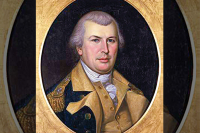Beauty, form and function go hand in hand
All too often, we tend to think of flowering plants as something beautiful put on this earth to stimulate human sensibilities.
Nothing, of course, could be less true.
Plants produce flowers to attract pollinators or otherwise distribute pollen in order to achieve fertilization — preferably cross-fertilization — and produce fruit (or seed) so as to assure the viability and continuation of a given species. Beauty, as we perceive it, is a mere side-product of this essential process. Beauty is as beauty does.
At the heart of this reproductive process is the pollen produced on the anthers of the flower stamens, the male part of the plant. In order to achieve fertilization, pollen must be transferred from the stamens to the female part, the pistil, of the same or another flower. This transferral is most often obtained via the wind or by insects.
The beautiful and highly individual sculpturing of a pollen grain’s outer wall is a unique feature of each plant species; so much so, in fact, that scientists have been able to determine the abundance of some species over time by separating pollen from cores of peat extracted from acid bogs.
Next spring, as you find your favorite wildflowers in bloom, take time to note the presence or absence of stamens. When stamens are present, see if pollen grains are on the anthers. Their specific configuration can be observed with a 10X magnifier. You will be looking directly at one of the most beautiful and functional aspects of the natural world. Beauty follows form.
Related Items
In a natural history classic titled This Green World, first published in 1942, Rutherford Platt devoted four chapters to pollen forms and the intricacies of pollination. The most interesting of these chapters, for me, is the the one titled “Pollen Jewelry and How Flowers Guard It.” Here are some of the points Platt makes:
• “Each pollen grain is like an exquisite piece of jewelry. Its size, shape and sculpturing are distinctive for the kind of plant which makes it.”
• “The sizes of pollen grains are not in proportion to the sizes of their plants. The pollen of a sequoia tree that grows to a height of over 300 feet happens to be about the same size as the pollen of a violet.
• “Althea and hibiscus and the members of the four-o’clock family are famous for their large pollen grains. The smallest grains are produced by the forget-me-not. They are about one ten-thousandth of an inch in diameter.”
• “The outside cover of pollen with its wonderful sculptured armor is practically indestructible. This fact has written a fascinating chapter in the fossil history of the lush plant life of pre-historic times. Pollen is preserved perfectly, as though prepared for a scientist’s microscope, in the coal measures of the carboniferous age, after 250 million years.”
• “This kind of longevity, however, is interesting only to man and not to nature. The brief life of most kinds of pollen requires that it be launched, transported and go to work on a pistil quickly — usually within an hour or two. All this must be done between showers, too, for pollen is damaged by rain. To keep their powder dry flowers are equipped with special structures as well as the ability to twist and turn to protect their anthers from rain drops.”
• “Some flowers are built so that they never have to take action to keep their pollen dry. A beautiful example of well-housed anthers is the Jack-in-the-pulpit with its graceful and sturdy hood. The flowers of the wild ginger and May-apple grow under a broad protecting leaf. The quivering bright orange touch-me-not often has a leaf, like a tiny umbrella, over its blossom.”
• “The structure of the flower itself may help keep its pollen dry. Some have petals always closed over the stamens. This is vividly true of the clovers and all other members of the pea family ... In the iris a great broad stigma makes a roof over the stamens ... Many others like Solomon’s seal, bellwort, columbine, and milkweed dangle face down.”
And so it goes — beauty, form, and function go hand in hand.
George Ellison wrote the biographical introductions for the reissues of two Appalachian classics: Horace Kephart’s Our Southern Highlanders and James Mooney’s History, Myths, and Sacred Formulas of the Cherokees. In June 2005, a selection of his Back Then columns was published by The History Press in Charleston as Mountain Passages: Natural and Cultural History of Western North Carolina and the Great Smoky Mountains. Readers can contact him at P.O. Box 1262, Bryson City, N.C., 28713, or at This email address is being protected from spambots. You need JavaScript enabled to view it..









